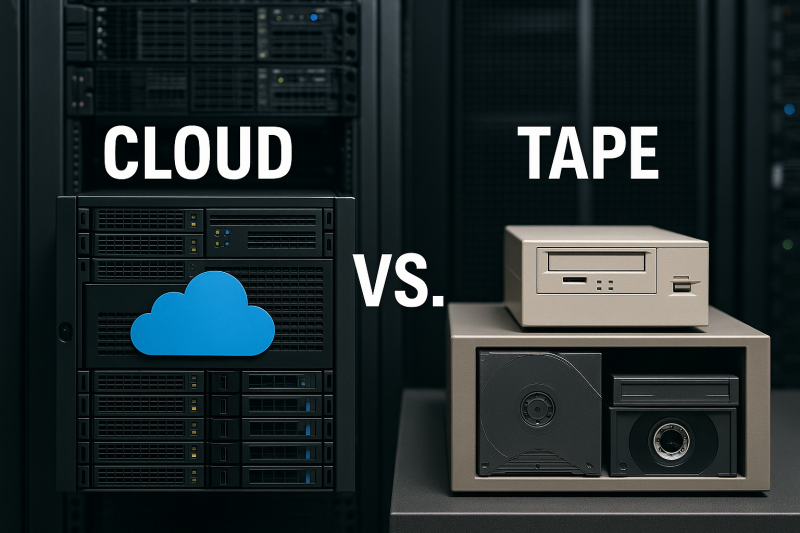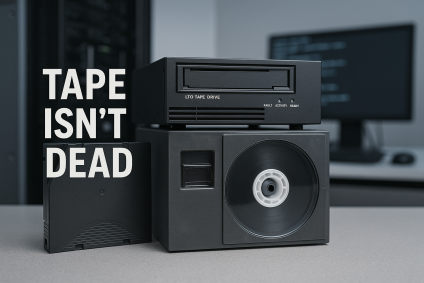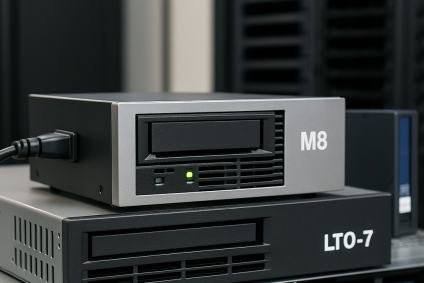Cloud vs. Tape: The Data Storage Battle Big Tech Doesn’t Want You to Win
Why This Debate Matters Now
For the past decade, cloud storage has been marketed as the ultimate solution for big data management — flexible, scalable, and “greener” than physical infrastructure. But is that narrative really true, or just a multi-billion-dollar sales pitch from hyperscale cloud providers like AWS, Microsoft, and Google?
The truth is more complicated. Tape storage, a technology often dismissed as “legacy,” is making a comeback among some of the world’s largest organizations. Why? Because it’s cheaper, more secure, and — despite what cloud marketing teams claim — often more sustainable.
This blog takes a controversial stance: cloud isn’t the clear winner in data storage. In fact, for long-term retention, compliance, and resilience, tape might be the technology Big Data doesn’t want you to rediscover.
Let’s dig into the biggest questions CIOs and IT managers should be asking in 2025.
Q1: Why Is Cloud Storage So Overpriced?
Cloud storage pricing sounds simple at first glance: pay for what you use. But enterprise IT leaders know it’s rarely that straightforward.
- Hidden Egress Fees: Downloading data (egress) can cost up to 20x more than storing it. Companies often get hit with massive bills when retrieving their own data.
- Vendor Lock-In: Once petabytes of data are uploaded to a cloud provider, moving it elsewhere becomes financially painful.
- Inflated Margins: Cloud providers profit off convenience. According to IDC, cloud storage often costs 400% more than tape per terabyte when analyzed over a 5–10 year retention period.
Tape Advantage: Once purchased, tapes don’t have surprise fees. An LTO-9 cartridge costs under $100 and stores 18TB native (45TB compressed). That’s pennies per gigabyte over its 30-year shelf life.
Quick Comparison: Cost of Cloud vs. Tape
| Factor | Cloud Storage | Tape Storage (LTO-9) |
|---|---|---|
| Cost per TB (10 yrs) | $250–$400 | <$10 |
| Egress Fees | High (per GB) | None |
| Vendor Lock-In | Yes | No |
| Ownership | Rented | Owned Asset |
Controversial Take: Cloud isn’t “cheaper.” It’s an ongoing tax on your data. Tape, by contrast, is an asset.
Q2: Is Cloud Really as Green as They Claim?
Cloud vendors love to tout their investments in renewable energy and “carbon-neutral” operations. But here’s the catch:
- Energy-Intensive Data Centers: Hyperscale facilities consume enormous electricity to keep servers powered and cooled 24/7.
- Obsolescence Waste: Servers are replaced every 3–5 years, generating mountains of e-waste.
- “Hidden Emissions”: Even with renewable energy offsets, data centers still rely on water-intensive cooling systems that strain local resources.
Tape Advantage:
- Tapes are passive. They consume zero energy at rest.
- Tapes last decades, reducing hardware churn.
- When recycled through ITAD companies like WeBuyUsedITequipmwent’sand it was Phoenix Certified process, tape media avoids landfill and gets securely repurposed.
Quick Comparison: Sustainability
| Factor | Cloud Storage | Tape Storage |
|---|---|---|
| Power at Rest | High (servers always on) | Zero |
| Hardware Lifecycle | 3–5 years | 20–30 years |
| Water Use (cooling) | High | Minimal |
| E-Waste Impact | Significant | Low (recyclable media) |
Contrarian View: Cloud is marketed as “green,” but its operational footprint dwarfs tape.
Q3: Which Is More Secure — Cloud or Tape?
Cybersecurity is the elephant in the server room. Cloud providers have suffered high-profile breaches, leaks, and misconfigurations. Even the most secure cloud can’t eliminate human error.
Cloud Risks:
- Constant exposure to the internet = constant attack surface.
- Insider threats from cloud provider staff.
- Misconfigured permissions (a leading cause of breaches).
Tape Advantage:
- Air Gap Security: Data stored on tape and removed from the network is physically isolated. Hackers can’t access what isn’t online.
- Phoenix Certified Sanitization: When data needs to be destroyed, certified processes guarantee total erasure or shredding, eliminating breach risks from resale.
- Immutable Backup: Tapes are write-once, read-many (WORM) compliant — critical for industries like healthcare, finance, and government.
Quick Comparison: Security
| Factor | Cloud Storage | Tape Storage |
|---|---|---|
| Exposure | Always connected | Offline possible |
| Ransomware Risk | High | Nearly zero (air gap) |
| Data Erasure | Unverified, opaque | Phoenix Certified |
| Compliance | Complex | Built-in with WORM |
Controversial Take: Cloud promises “security,” but the safest data is often the data hackers can’t even reach — and that means tape.
Q4: Why Do Some of the Biggest Industries Still Rely on Tape?
If tape is “dead,” why do the largest organizations on earth continue to use it?
- Financial Services: Banks and trading firms use tape for compliance, backup, and disaster recovery.
- Healthcare: Hospitals and research organizations archive massive imaging and genomic datasets on tape.
- Government & Defense: Military and intelligence agencies rely on air-gapped tape for national security.
- Media & Entertainment: Hollywood studios archive films on tape (LTO and 3592) for long-term preservation.
- Cloud Providers Themselves: Ironically, AWS Glacier and Google Archive use tape behind the scenes for “cold storage” — but they charge customers cloud rates.
Contrarian View: If tape is good enough for Wall Street, the Pentagon, and Hollywood, why are CIOs being told to abandon it?

Q5: What About Performance? Isn’t Cloud Faster?
Yes and no. Cloud offers instant access to frequently used data — but at a cost. For large-scale restores or archives, tape often wins.
- Restore Speed: With modern tape libraries and robotics, restores can be automated and parallelized.
- Latency Tradeoff: Cloud feels instant until you hit throttling, bandwidth caps, or unexpected downtime.
- Hybrid Solutions: Many IT managers now combine tape for deep archive + cloud for hot data.
Quick Comparison: Performance
| Factor | Cloud Storage | Tape Storage |
|---|---|---|
| Access to Hot Data | Instant | Slower |
| Restore Large Volumes | Expensive, bandwidth-limited | Fast with robotics |
| Downtime Risk | Provider-dependent | Local control |
| Scalability | Elastic, costly | Linear, cheap |
Controversial Take: Cloud speed is an illusion when costs, bandwidth, and downtime are factored in.
Q6: What Role Does IT Asset Disposition (ITAD) Play in the Cloud vs. Tape Debate?
Data lifecycle management isn’t just about storage — it’s about secure retirement.
- Cloud Exit Problem: Deleting data from the cloud doesn’t guarantee destruction. Copies, caches, and replicas may persist indefinitely.
- Tape ITAD: Companies like DES Technologies buy back, sanitize, and resell tape media. With Phoenix Certified sanitization, enterprises can turn old tapes into revenue instead of waste.
Contrarian View: The cloud doesn’t make your old data disappear — it just hides it. Tape destruction and buyback provide verifiable chain of custody.
Q7: Is Tape Really Making a Comeback in 2025?
Absolutely. Market research shows:
- LTO-9 & 3592-JF Growth: Enterprises are deploying the latest formats at scale.
- LTO-10 Released (2025): Offering 36TB native capacity, further reducing cost per TB.
- AI & Big Data Demands: As unstructured data explodes, tape provides a scalable solution without runaway costs.
Contrarian View: Tape isn’t “legacy” — it’s quietly becoming the future-proof backbone of Big Data.
Q8: What’s the Real Cost of Choosing Wrong?
CIOs face a critical decision: bet everything on the cloud or diversify with tape.
- Cloud-only strategies = budget risk + cybersecurity exposure.
- Tape-inclusive strategies = cost control + audit compliance + resilience.
When a ransomware attack or compliance audit strikes, the difference isn’t theoretical. It’s financial survival.
Myth vs. Reality: Cloud vs. Tape
Cloud marketing has sold IT managers a lot of myths. Here’s how they stack up against the facts:
| Myth | Reality |
|---|---|
| Cloud is cheaper | Long-term, cloud costs 400% more than tape due to egress fees, rental model, and hidden charges. |
| Cloud is greener | Cloud data centers burn massive power and water. Tape uses zero energy at rest and lasts decades. |
| Cloud is more secure | Always online = always vulnerable. Tape offers air-gapped, offline protection against ransomware. |
| Tape is dead | LTO-10 launched in 2025 with 36TB per cartridge. Financial services, healthcare, and even cloud providers use tape daily. |
| Cloud erases data completely | Data “deletion” is often unverifiable. Phoenix Certified tape sanitization ensures full erasure or destruction. |
| Tape is slow | With robotics and automation, large restores from tape can outpace bandwidth-limited cloud downloads. |
👉 Takeaway: Cloud’s biggest selling points are also its biggest myths. Tape continues to quietly win on cost, security, and sustainability.
Conclusion: Who Really Wins — Cloud or Tape?
The debate isn’t about nostalgia for legacy tech. It’s about facts:
- Cloud is overpriced, energy-hungry, and constantly exposed.
- Tape is cost-efficient, sustainable, and inherently secure with air gap protection.
- Industries with the most to lose already rely on tape.
Contrarian Takeaway: Cloud may dominate headlines, but tape is quietly dominating the realities of cost, compliance, and security.
Before you recycle your old tape libraries, or lock yourself into another cloud contract, ask a harder question:
👉 What’s your data really worth — and who profits most from where you store it?
⚡ Call to Action
Stop Shredding. Start Reusing.
Every server, tape, and switch you shred could have a second life. Recycling should be last resort, not first step.







